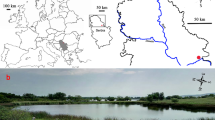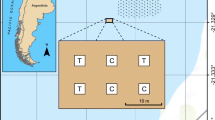Abstract
In recent years, the population of white-spotted charr (Salvelinus leucomaenis) has been declining in the upper reaches of the Daiya River, Nikko City, Tochigi Prefecture. One of the causes is the deterioration of the river environment due to an influx of sediment and construction work. Among the studies investigating the habitat preferences of charr, there are few examples of habitat assessment of stream channels severely altered by artificial structures, such as dams, revetments and concrete riverbeds. For this reason, this study investigated the presence/absence of charr in a reach with sequential low-head dams in the Daiya River that has all those structures. The results indicate that the presence of charr in the altered reach was associated with the abundance of rocks or greater water depth (>20 cm). Based on these results, we conclude that when trying to create a habitat for charr in a stream reach with sequential low-head dams, one should consider adding complexity in terms of rocks and water depth.



Similar content being viewed by others
References
Allan JD, Russek E (1985) The quantification of stream drift. Can J Fish Aquat Sci 42:210–215
Brett JR (1979) Environmental factors and growth. In: Hoar WS, Randall DJ, Brett JR (eds) Fish physiology. Vol. VIII. Academic Press, London, pp 599–675
Burnham KP, Anderson DR (2003) Model selection and multimodel inference: a practical information-theoretic approach. 2nd edn. Springer Science & Business Media, New York
Fausch KD (1984) Profitable stream positions for salmonids: relating specific growth rate to net energy gain. Can J Zool 62:441–451
Hill J, Grossman GD (1993) An energetic model of microhabitat use for rainbow trout and rosyside dace. Ecology 74:685–698
Hughes NF, Dill LM (1990) Position choice by drift-feeding salmonids: model and test for Arctic Grayling (Thymallus arcticus) in subarctic mountain streams, Interior Alaska. Can J Fish Aquat Sci 47:2039–2048
Kishi D, Maekawa K (2009) Stream-dwelling Dolly Varden (Salvelinus malma) density and habitat characteristics in stream sections installed with low-head dams in the Shiretoko Peninsula, Hokkaido, Japan. Ecol Res 24:873–880
Miyamoto K, Araki H (2019) Effects of water depth and structural complexity on survival and settlement of white-spotted charr (Salvelinus leucomaenis). Hydrobiologia 840:103–112
Miyamoto K, Araki H (2020) When is it good to be shy? Experimental evaluation of predation of juvenile salmon by riparian wildlife. Hydrobiologia 847:713–725
Miyamoto K, Kishi D, Araki H (2019) How do origin, body size and behavior of red-spotted masu salmon affect risk of predation by riparian wildlife? The Proceedings of the International Symposium on the 100th Anniversary of the Discovery of Formosa Landlocked Salmon. National Taiwan Museum, Taipei, pp 89–94
Morita K, Yamamoto S (2002) Effects of habitat fragmentation by damming on the persistence of stream-dwelling charr populations. Conserv Biol 16:1318–1323
Pringle CM, Freeman MC, Freeman BJ (2000) Regional effects of hydrologic alterations on riverine macrobiota in the new world: tropical–temperate comparisons. BioScience 50:807–823
Rosenfeld JS, Boss S (2001) Fitness consequences of habitat use for juvenile cutthroat trout: energetic costs and benefits in pools and riffles. Can J Fish Aquat Sci 58:585–593
Sahashi G, Morita K (2018) Adoption of alternative migratory tactics: a view from the ultimate mechanism and threshold trait changes in a salmonid fish. Oikos 127:239–251
Sahashi G, Morita K, Kishi D (2018) Spatial expansion and increased population density of masu salmon parr independent of river restoration. Ichthyol Res 65:496–501
Saito T, Kanazawa T, Morimoto K, Nakamichi K, Kawashima N, Suzuki K, Akagawa I (2013) Habitat selection and movements of Oncorhynchus masou ishikawae in a mountain stream interrupted by several small dams in stock management. J Sch Mar Sci Technol, Tokai Univ 10:1–10
Yamamoto S (1991) Charr the ecology and fishing. Tsuribitosha, Tokyo (in Japanese)
Acknowledgments
The authors would like to thank the parents and teachers of the Kiyotaki Elementary School, including Principal Kazuhiko Wakatsuki, for their understanding and cooperation in the survey activities of the “Charr-rangers” (elementary school students who participated in this study as part of their education program). We would also like to thank Mr. Norihisa Tanabe and Mr. Takashi Takeshima from the “Community-Reactivating Cooperator Squad” and Mr. Shunsuke Iwasaki from the “Shimotsuke Shinbun” for their help in preparation for the survey. The authors are grateful to Milos Djordjevic for checking the manuscript for grammatical and linguistic errors and providing valuable feedback on those issues.
Author information
Authors and Affiliations
Corresponding author
Ethics declarations
Conflict of interest
This work was supported by a grant-in-aid from the Ministry of Agriculture, Forestry and Fisheries, Japan.
Ethics approval
This study was conducted in accordance with Japanese regulations regarding the handling of wildlife (in this case fishes).
Additional information
Publisher's Note
Springer Nature remains neutral with regard to jurisdictional claims in published maps and institutional affiliations.
About this article
Cite this article
Miyamoto, K., Michita, Y., Hoshino, A. et al. Habitat use by white-spotted charr in a stream reach with sequential low-head dams in the Daiya River, central Japan. Ichthyol Res (2024). https://doi.org/10.1007/s10228-024-00960-6
Received:
Revised:
Accepted:
Published:
DOI: https://doi.org/10.1007/s10228-024-00960-6




